Do you have a hole in your cabinet door? Don’t worry, and it’s an easy fix. In this blog post, we will show you how to fix hole in cabinet doors using just a few simple tools and supplies. You can restore your cabinet door to its former glory with just a few simple steps. So without further ado, let’s get started!
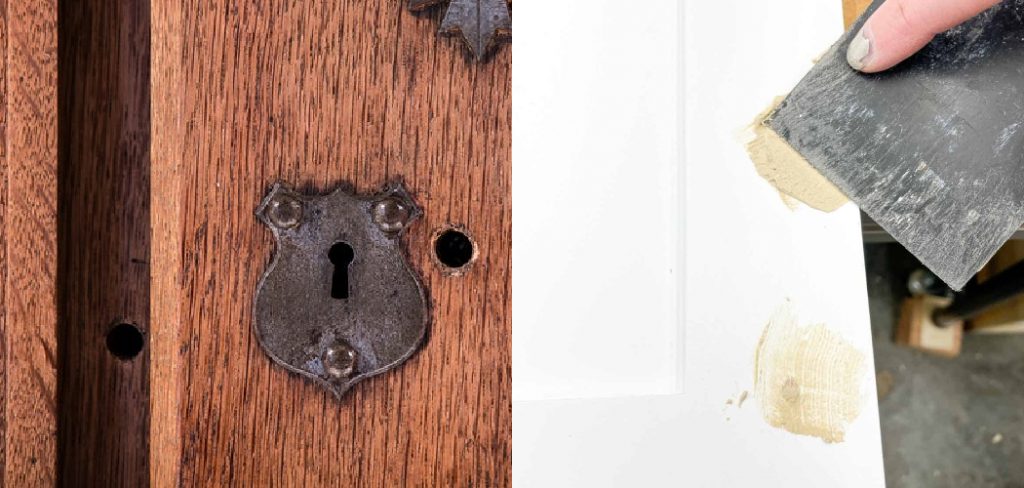
When your cabinet door has a hole, the easiest solution is to fix it with wood glue and a clamp. First, use a scrap piece of wood to mark the hole size on the cabinet door. Then, cut out a piece of wood the same size as the marked area. Next, brush some wood glue onto the back of the replacement piece of wood and attach it to the backside of the cabinet door over the hole. Read on for more information.
Why Should You Fix Hole in Cabinet Door?
Your kitchen cabinets see a lot of action. They get opened and closed multiple times a day, which can cause the door to developing a hole. Not only is this unsightly, but it can also let water and other debris inside the cabinet, damaging your dishes or other items stored inside. So, if you have a hole in your cabinet door, it’s important to fix it as soon as possible.
Fixing a hole in a cabinet door is not as difficult as it may seem. With some wood putty and a little elbow grease, you can easily fix it yourself. When fixing a cabinet door, remember to sand down the area around the hole. This will help create a smooth surface for the wood putty to adhere to. If you don’t sand the area, the wood putty may not stick as well and can eventually fall out.
How to Fix Hole in Cabinet Door: 10 Easy Solutions
1. Remove the Doors and Unscrew the Handles:
The first step to fixing a hole in a kitchen cabinet door is to remove the door and unscrew the handles. This will give you better access to the back of the door where the hole is located. Be careful not to damage the surrounding woodwork or hardware when removing the door. The screws may be difficult to remove if the door is very old. In this case, you may need to use a drill to remove them.
2. Cut a Piece of Wood to Fit the Hole:
You need to cut a piece of wood to fit the hole where the door was. A piece of plywood or particle board will work well. If the hole is large, you may need to use two pieces of wood. You can also use any wood, but you may need to sand it down to make it fit snugly. Make sure the piece of wood is the same thickness as the door.
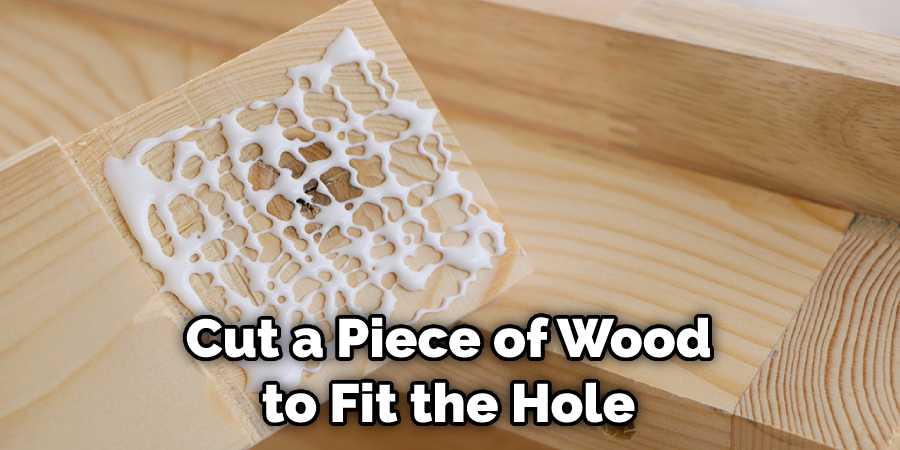
3. Attach the Piece of Wood to the door:
Once you’ve cut the piece of wood to size, you’ll need to attach it to the door. You can do this by using wood glue and some small nails. First, apply a generous amount of wood glue to the back of the piece of wood. Then, press it firmly into place on the door. Next, use a hammer to drive a few small nails through the wood and into the door. This will help to hold the piece of wood in place while the glue dries.
4. Allow the Glue to Dry:
First, you will need to apply glue to the door and nails. Then, you will need to wait for the glue to dry. This usually takes about 24 hours. During this time, it is important to make sure that the door is not opened or closed so that the piece of wood stays in place. Once the glue is dry, you can remove the nails and enjoy your new door!
5. Add a New Handle or Knob:
If your cabinets look a little shabby, you can easily give them new life by adding new handles or knobs. This is quick and easy to do, and it can make a big difference in the overall look of your kitchen. You can find new hardware at any home improvement store or order it online. Be sure to measure the holes in your cabinet doors before purchasing new hardware so you know what size to get.
6. Add Cabinet Hardware:
After the glue is dry, you can add cabinet hardware to the door. This includes handles, knobs, and pulls. You will want to ensure the hardware is properly aligned and level. Once the hardware is in place, you can add any final touches to the door, such as paint or stains. If the hole in the cabinet door is large, you may consider adding a piece of trim or molding to cover it up.
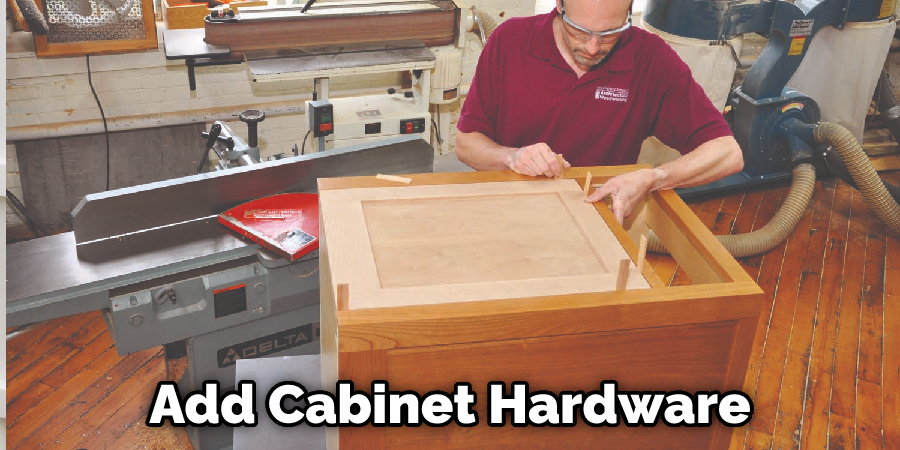
7. Use a Wood Filler:
If the hole in your cabinet door is too big to be covered with a wood patch, you’ll need to use a wood filler. Be sure to read the directions on the wood filler carefully before using it. You may need to apply several coats of wood filler to fill the hole completely.
Also, ensure the wood filler is completely dry before sanding it down. Once the wood filler is dry, sand it down until it’s flush with the rest of the door. If necessary, apply a second coat of wood filler and sand that down as well. After the wood filler is smooth, you can repaint or re-stain the cabinet door to match the rest of your cabinets.
You Can Check It Out To Fix Door Trim Chewed by Dog
8. Sand the Area Smooth:
Once the wood filler is dry, you’ll need to sand it down so it is flush with the rest of the cabinet door. You can use a hand sander or a power sander for this step. Be sure to use fine-grit sandpaper so you don’t damage the door. When sanding the area, be sure to go with the grain of the wood.
9. Prime and Paint the Door:
Once you’ve sanded the area smooth, you’ll need to prime and paint the door to match the rest of the cabinets. When priming the door, make sure to use a paint primer designed for laminate surfaces. Once the primer is dry, you can paint the door with a semi-gloss or high-gloss paint to give it a nice finish.
10. Rehang the Cabinet Door:
Once the door is dry, you can rehang it on the cabinet. Ensure the hinges are properly aligned and the door is level before screwing it back into place. If the door is not level, it may not close properly or line up with the other doors in the cabinet. When you are finished, you should have a sturdy, level cabinet door that will look great in your kitchen or bathroom.
You Can Check It Out To Fix Screw Holes in Cabinets
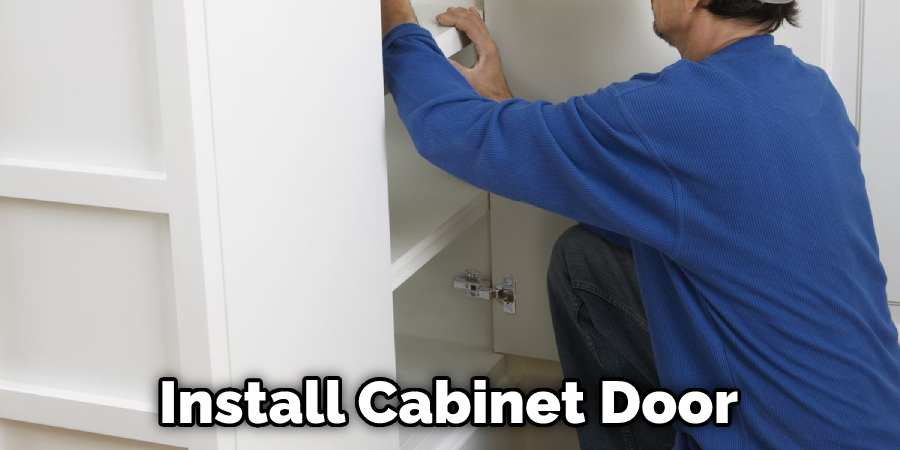
Some Tips to Prevent Holes in Cabinet Doors:
- Ensure the door is properly aligned in the frame before drilling any holes.
- Use a spade bit, or hole saw that is the same size as the knob or handle you are installing.
- Be careful not to over-tighten the screws when attaching hardware to avoid stripping the wood.
- Predrill all holes to avoid splitting the wood.
- Use shims to level and align doors before attaching hardware.
- Use a finish that will resist marring and scratching, such as polyurethane.
- Regularly check cabinet doors to ensure the hardware is tight and there are no gaps around the doors.
Can You Patch a Hole in a Cabinet Door?
Yes, you can patch a hole in a cabinet door with wood putty or filler. First, clean out the hole with a putty knife to remove any dirt or debris. Next, apply the wood putty or filler to the hole and smooth it out with the putty knife. Finally, allow the putty or filler to dry completely before painting or stain the door.
If the hole in the cabinet door is large, you may need to use a piece of wood to patch it. First, cut a piece of wood slightly larger than the hole. Next, glue the piece of wood to the back of the door. Finally, use clamps to hold the piece of wood in place until the glue dries. When the glue is dry, sand the area around the patch until it is smooth.
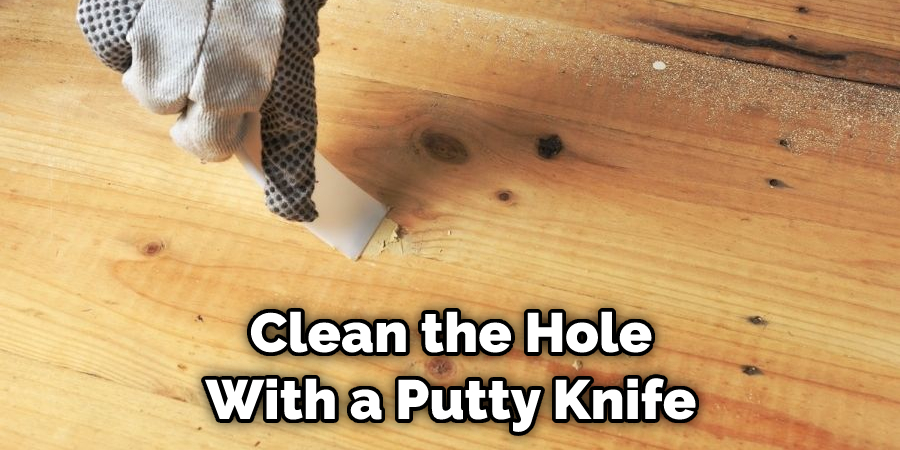
Frequently Asked Questions
Can You Fill a Hole in a Cabinet?
Probably not. Unless you’re a drill sergeant and have some handy woodworking skills, it is probably best to leave cabinet holes unfilled. Instead, try using filler materials like spackle or caulk. These products are designed specifically for filling in gaps and cracks and can be easily concealed with paint or wallpaper once the area is finished.
What Do You Use to Fill Screw Holes?
There are many different options when it comes to filling screw holes, but the most popular include wood screws, drywall anchors, and duct tape. Each of these materials has its own advantages and disadvantages, so it is important to choose the one that is best suited for your needs.
Wood screws are well-known for their durability and corrosion resistance, making them a good choice if you need long-term constant use from your hole filler. However, they can be difficult to remove once installed due to their tight fit into the substrate. Drywall anchors are generally less expensive than wood screws or nails but offer limited longevity because they cannot withstand heavy loads. Duct tape also offers an economical solution because it’s easy to apply and removes easily without leaving any residue behind.
Is It Better to Use Wood Filler or Caulk?
This is a question that often comes up when trying to decide which type of sealant to use. Here are a few things to consider when choosing between wood filler and caulking:
-Cost: Wood filler is typically cheaper than caulking, but it may not last as long.
-Durability: Wood filler is less durable than caulking, so it may not hold up as well to weather conditions or repeated use.
-Resilience: Wood filler may not be as resistant to water penetration as caulking.
-Appearance: Wood filler may not look as good as caulking once it’s dried.
Do You Use Wood Putty on Cabinet Doors?
There is some debate over whether or not wood putty is an effective way to repair cabinet doors. Some people believe that it can provide temporary relief from the door’s flexing and warping, while others claim that it is only suitable for small fixes and does not correct any underlying problems. Ultimately, if you’re looking to fix your door permanently, then professional help may be best suited for you.
Conclusion
If you are experiencing water leaking from your air conditioner, there are a few things you can do to try and fix the issue. We have outlined some of these solutions for you in this blog post. However, if the problem persists or gets worse, it is best to call a professional to come to take a look at your AC unit.
Hopefully, following the tips in this post on how to fix hole in cabinet door will help you get your air conditioner up and running again without any leaks. So there you have it! A few solutions to fixing that pesky hole in your cabinet door. With a little effort, you’ll have that hole patched up before you know it. Thanks for reading!
You Can Chack It Out Fix Wood Rot on Door Frame
